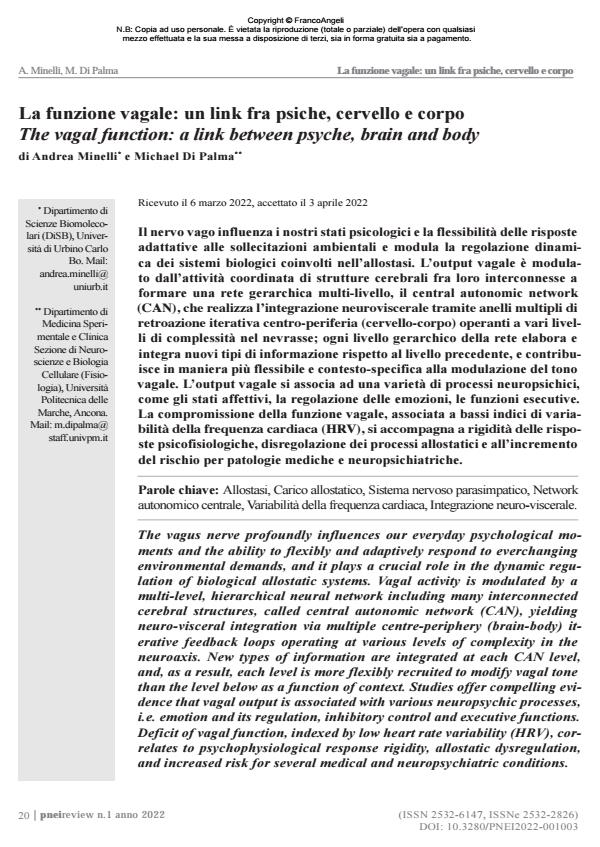La funzione vagale: un link fra psiche, cervello e corpo
Titolo Rivista PNEI REVIEW
Autori/Curatori Andrea Minelli, Michael Di Palma
Anno di pubblicazione 2022 Fascicolo 2022/1
Lingua Italiano Numero pagine 18 P. 20-37 Dimensione file 320 KB
DOI 10.3280/PNEI2022-001003
Il DOI è il codice a barre della proprietà intellettuale: per saperne di più
clicca qui
Qui sotto puoi vedere in anteprima la prima pagina di questo articolo.
Se questo articolo ti interessa, lo puoi acquistare (e scaricare in formato pdf) seguendo le facili indicazioni per acquistare il download credit. Acquista Download Credits per scaricare questo Articolo in formato PDF

FrancoAngeli è membro della Publishers International Linking Association, Inc (PILA)associazione indipendente e non profit per facilitare (attraverso i servizi tecnologici implementati da CrossRef.org) l’accesso degli studiosi ai contenuti digitali nelle pubblicazioni professionali e scientifiche
Il nervo vago influenza i nostri stati psicologici e la flessibilità delle risposte adattative alle sollecitazioni ambientali e modula la regolazione dinamica dei sistemi biologici coinvolti nell’allostasi. L’output vagale è modulato dall’attività coordinata di strutture cerebrali fra loro interconnesse a formare una rete gerarchica multi-livello, il central autonomic network (CAN), che realizza l’integrazione neuroviscerale tramite anelli multipli di retroazione iterativa centro-periferia (cervello-corpo) operanti a vari livelli di complessità nel nevrasse; ogni livello gerarchico della rete elabora e integra nuovi tipi di informazione rispetto al livello precedente, e contribuisce in maniera più flessibile e contesto-specifica alla modulazione del tono vagale. L’output vagale si associa ad una varietà di processi neuropsichici, come gli stati affettivi, la regolazione delle emozioni, le funzioni esecutive. La compromissione della funzione vagale, associata a bassi indici di variabilità della frequenza cardiaca (HRV), si accompagna a rigidità delle risposte psicofisiologiche, disregolazione dei processi allostatici e all’incremento del rischio per patologie mediche e neuropsichiatriche.
Parole chiave:Allostasi, Carico allostatico, Sistema nervoso parasimpatico, Network autonomico centrale, Variabilità della frequenza cardiaca, Integrazione neuro-viscerale.
Andrea Minelli, Michael Di Palma, La funzione vagale: un link fra psiche, cervello e corpo in "PNEI REVIEW" 1/2022, pp 20-37, DOI: 10.3280/PNEI2022-001003